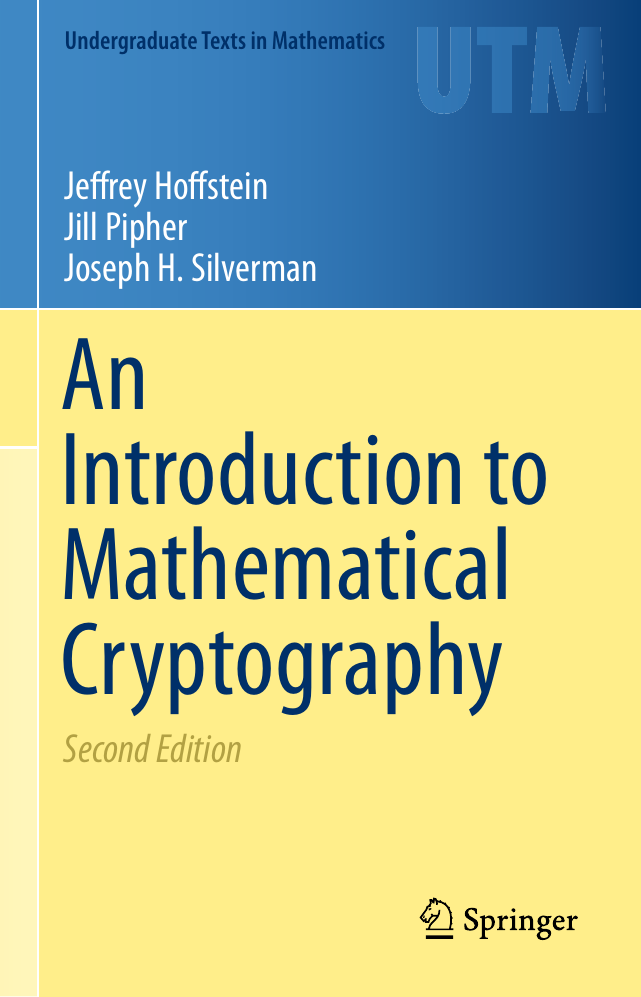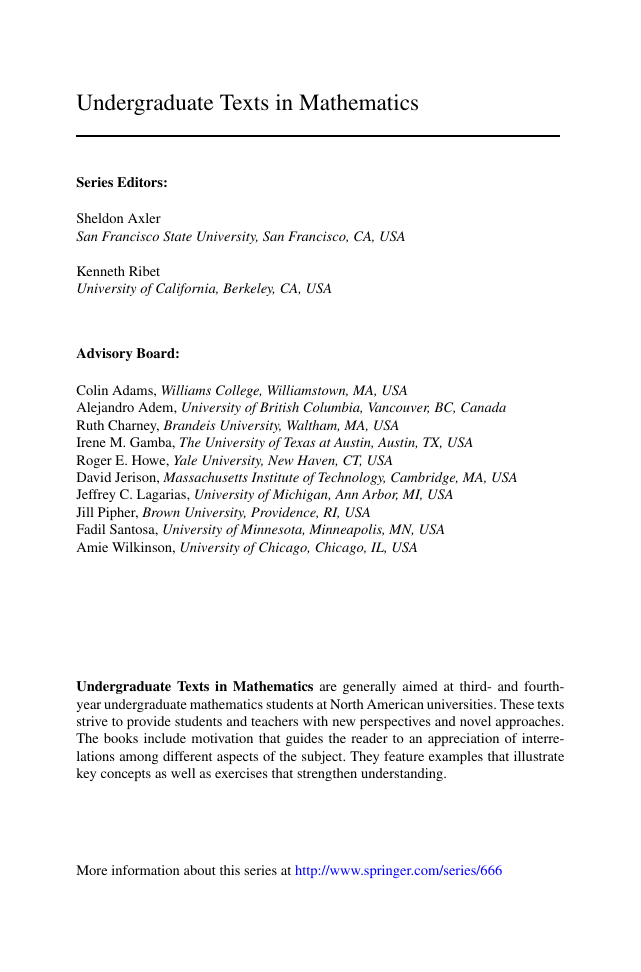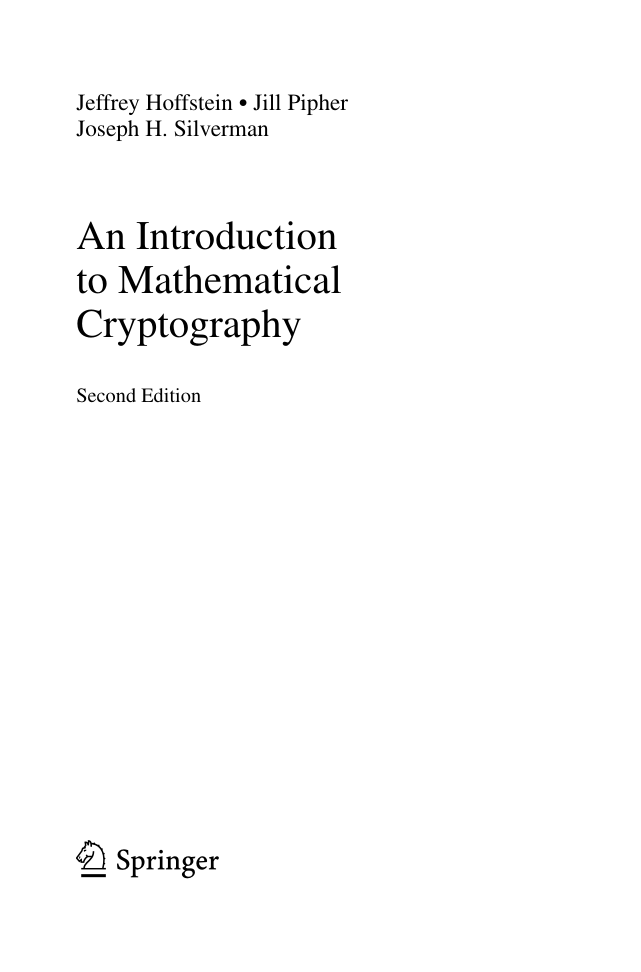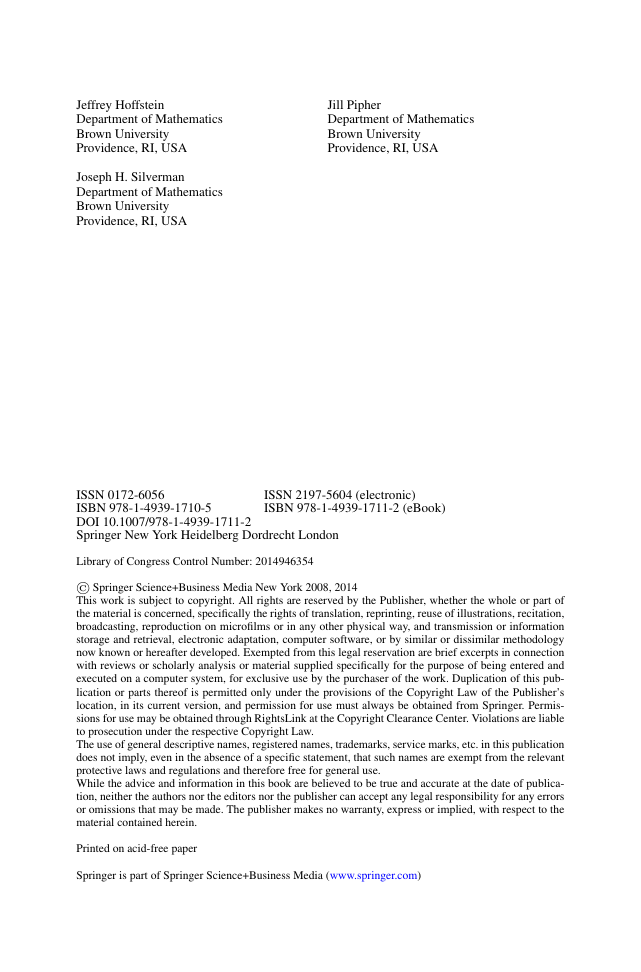Preface
Contents
Introduction
1 An Introduction to Cryptography
1.1 Simple Substitution Ciphers
1.1.1 Cryptanalysis of Simple Substitution Ciphers
1.2 Divisibility and Greatest Common Divisors
1.3 Modular Arithmetic
1.3.1 Modular Arithmetic and Shift Ciphers
1.3.2 The Fast Powering Algorithm
1.4 Prime Numbers, Unique Factorization, and Finite Fields
1.5 Powers and Primitive Roots in Finite Fields
1.6 Cryptography Before the Computer Age
1.7 Symmetric and Asymmetric Ciphers
1.7.1 Symmetric Ciphers
1.7.2 Encoding Schemes
1.7.3 Symmetric Encryption of Encoded Blocks
1.7.4 Examples of Symmetric Ciphers
1.7.5 Random Bit Sequences and Symmetric Ciphers
1.7.6 Asymmetric Ciphers Make a First Appearance
Exercises
2 Discrete Logarithms and Diffie–Hellman
2.1 The Birth of Public Key Cryptography
2.2 The Discrete Logarithm Problem
2.3 Diffie–Hellman Key Exchange
2.4 The Elgamal Public Key Cryptosystem
2.5 An Overview of the Theory of Groups
2.6 How Hard Is the Discrete Logarithm Problem?
2.7 A Collision Algorithm for the DLP
2.8 The Chinese Remainder Theorem
2.8.1 Solving Congruences with Composite Moduli
2.9 The Pohlig–Hellman Algorithm
2.10 Rings, Quotients, Polynomials, and Finite Fields
2.10.1 An Overview of the Theory of Rings
2.10.2 Divisibility and Quotient Rings
2.10.3 Polynomial Rings and the Euclidean Algorithm
2.10.4 Polynomial Ring Quotients and Finite Fields
Exercises
3 Integer Factorization and RSA
3.1 Euler's Formula and Roots Modulo pq
3.2 The RSA Public Key Cryptosystem
3.3 Implementation and Security Issues
3.4 Primality Testing
3.4.1 The Distribution of the Set of Primes
3.4.2 Primality Proofs Versus Probabilistic Tests
3.5 Pollard's p-1 Factorization Algorithm
3.6 Factorization via Difference of Squares
3.7 Smooth Numbers and Sieves
3.7.1 Smooth Numbers
3.7.2 The Quadratic Sieve
3.7.3 The Number Field Sieve
3.8 The Index Calculus and Discrete Logarithms
3.9 Quadratic Residues and Quadratic Reciprocity
3.10 Probabilistic Encryption
Exercises
4 Digital Signatures
4.1 What Is a Digital Signature?
4.2 RSA Digital Signatures
4.3 Elgamal Digital Signatures and DSA
Exercises
5 Combinatorics, Probability, and Information Theory
5.1 Basic Principles of Counting
5.1.1 Permutations
5.1.2 Combinations
5.1.3 The Binomial Theorem
5.2 The Vigenère Cipher
5.2.1 Cryptanalysis of the Vigenère Cipher: Theory
5.2.2 Cryptanalysis of the Vigenère Cipher: Practice
5.3 Probability Theory
5.3.1 Basic Concepts of Probability Theory
5.3.2 Bayes's Formula
5.3.3 Monte Carlo Algorithms
5.3.4 Random Variables
5.3.5 Expected Value
5.4 Collision Algorithms and Meet-in-the-Middle Attacks
5.4.1 The Birthday Paradox
5.4.2 A Collision Theorem
5.4.3 A Discrete Logarithm Collision Algorithm
5.5 Pollard's ρ Method
5.5.1 Abstract Formulation of Pollard's ρ Method
5.5.2 Discrete Logarithms via Pollard's ρ Method
5.6 Information Theory
5.6.1 Perfect Secrecy
5.6.2 Entropy
5.6.3 Redundancy and the Entropyof Natural Language
5.6.4 The Algebra of Secrecy Systems
5.7 Complexity Theory and P Versus NP
Exercises
6 Elliptic Curves and Cryptography
6.1 Elliptic Curves
6.2 Elliptic Curves over Finite Fields
6.3 The Elliptic Curve Discrete Logarithm Problem
6.3.1 The Double-and-Add Algorithm
6.3.2 How Hard Is the ECDLP?
6.4 Elliptic Curve Cryptography
6.4.1 Elliptic Diffie–Hellman Key Exchange
6.4.2 Elliptic Elgamal Public Key Cryptosystem
6.4.3 Elliptic Curve Signatures
6.5 The Evolution of Public Key Cryptography
6.6 Lenstra's Elliptic Curve Factorization Algorithm
6.7 Elliptic Curves over F2 and over F2k
6.8 Bilinear Pairings on Elliptic Curves
6.8.1 Points of Finite Order on Elliptic Curves
6.8.2 Rational Functions and Divisors on Elliptic Curves
6.8.3 The Weil Pairing
6.8.4 An Efficient Algorithm to Compute the Weil Pairing
6.8.5 The Tate Pairing
6.9 The Weil Pairing over Fields of Prime Power Order
6.9.1 Embedding Degree and the MOV Algorithm
6.9.2 Distortion Maps and a Modified Weil Pairing
6.9.3 A Distortion Map on y2=x3+x
6.10 Applications of the Weil Pairing
6.10.1 Tripartite Diffie–Hellman Key Exchange
6.10.2 ID-Based Public Key Cryptosystems
Exercises
7 Lattices and Cryptography
7.1 A Congruential Public Key Cryptosystem
7.2 Subset-Sum Problems and Knapsack Cryptosystems
7.3 A Brief Review of Vector Spaces
7.4 Lattices: Basic Definitions and Properties
7.5 Short Vectors in Lattices
7.5.1 The Shortest and the Closest Vector Problems
7.5.2 Hermite's Theorem and Minkowski's Theorem
7.5.3 The Gaussian Heuristic
7.6 Babai's Algorithm
7.7 Cryptosystems Based on Hard Lattice Problems
7.8 The GGH Public Key Cryptosystem
7.9 Convolution Polynomial Rings
7.10 The NTRU Public Key Cryptosystem
7.10.1 NTRUEncrypt
7.10.2 Mathematical Problems for NTRUEncrypt
7.11 NTRUEncrypt as a Lattice Cryptosystem
7.11.1 The NTRU Lattice
7.11.2 Quantifying the Security of an NTRU Lattice
7.12 Lattice-Based Digital Signature Schemes
7.12.1 The GGH Digital Signature Scheme
7.12.2 Transcript Analysis
7.12.3 Rejection Sampling
7.12.4 Rejection Sampling Applied to an Abstract Signature Scheme
7.12.5 The NTRU Modular Lattice Signature Scheme
7.13 Lattice Reduction Algorithms
7.13.1 Gaussian Lattice Reduction in Dimension 2
7.13.2 The LLL Lattice Reduction Algorithm
7.13.3 Using LLL to Solve apprCVP
7.13.4 Generalizations of LLL
7.14 Applications of LLL to Cryptanalysis
7.14.1 Congruential Cryptosystems
7.14.2 Applying LLL to Knapsacks
7.14.3 Applying LLL to GGH
7.14.4 Applying LLL to NTRU
Exercises
8 Additional Topics in Cryptography
8.1 Hash Functions
8.2 Random Numbers and Pseudorandom Number
8.3 Zero-Knowledge Proofs
8.4 Secret Sharing Schemes
8.5 Identification Schemes
8.6 Padding Schemes and the Random Oracle Model
8.7 Building Protocols from Cryptographic Primitives
8.8 Blind Digital Signatures, Digital Cash, and Bitcoin
8.9 Homomorphic Encryption
8.10 Hyperelliptic Curve Cryptography
8.11 Quantum Computing
8.12 Modern Symmetric Cryptosystems: DES and AES
List of Notation
References
Index
















 2023年江西萍乡中考道德与法治真题及答案.doc
2023年江西萍乡中考道德与法治真题及答案.doc 2012年重庆南川中考生物真题及答案.doc
2012年重庆南川中考生物真题及答案.doc 2013年江西师范大学地理学综合及文艺理论基础考研真题.doc
2013年江西师范大学地理学综合及文艺理论基础考研真题.doc 2020年四川甘孜小升初语文真题及答案I卷.doc
2020年四川甘孜小升初语文真题及答案I卷.doc 2020年注册岩土工程师专业基础考试真题及答案.doc
2020年注册岩土工程师专业基础考试真题及答案.doc 2023-2024学年福建省厦门市九年级上学期数学月考试题及答案.doc
2023-2024学年福建省厦门市九年级上学期数学月考试题及答案.doc 2021-2022学年辽宁省沈阳市大东区九年级上学期语文期末试题及答案.doc
2021-2022学年辽宁省沈阳市大东区九年级上学期语文期末试题及答案.doc 2022-2023学年北京东城区初三第一学期物理期末试卷及答案.doc
2022-2023学年北京东城区初三第一学期物理期末试卷及答案.doc 2018上半年江西教师资格初中地理学科知识与教学能力真题及答案.doc
2018上半年江西教师资格初中地理学科知识与教学能力真题及答案.doc 2012年河北国家公务员申论考试真题及答案-省级.doc
2012年河北国家公务员申论考试真题及答案-省级.doc 2020-2021学年江苏省扬州市江都区邵樊片九年级上学期数学第一次质量检测试题及答案.doc
2020-2021学年江苏省扬州市江都区邵樊片九年级上学期数学第一次质量检测试题及答案.doc 2022下半年黑龙江教师资格证中学综合素质真题及答案.doc
2022下半年黑龙江教师资格证中学综合素质真题及答案.doc